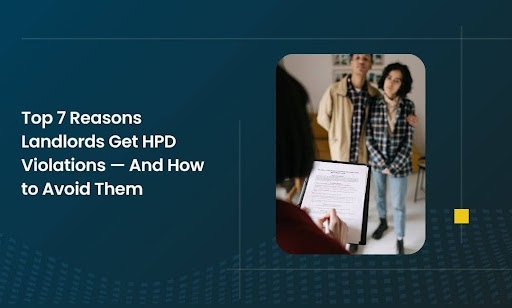HPD violations can hit your wallet hard — with fines reaching $1,000+ per violation and potential housing court appearances that drag on for months. Yet most NYC landlords keep making the same preventable mistakes that trigger these costly violations year after year.
You’re about to learn exactly what HPD inspectors look for and how to stay ahead of violations before they happen. This guide breaks down the most common violation triggers and gives you actionable steps to protect your properties.
Here’s what we’ll cover:
- The top 4 environmental hazards that account for most of all HPD violations (pests, mold, heat/hot water, and lead paint)
- Critical safety violations that inspectors check first (window guards, smoke detectors, and self-closing doors)
- Practical prevention strategies and compliance timelines for each violation type
We’ve helped hundreds of NYC property owners track and resolve their HPD violations through ViolationWatch. Our platform sends you instant alerts when violations hit, so you never miss critical deadlines. Plus, you get step-by-step resolution guidance from compliance experts who know HPD inside and out.
Environmental Hazards That Trigger Most HPD Violations
Environmental hazards plague NYC rental properties more than any other violation category. These four issues alone generate thousands of violations each year, costing landlords millions in fines and repairs. Let’s break down each hazard and how you can stay compliant.
1. Pest Infestations — The Silent Property Value Killer
Pest problems spiral out of control fast. What starts as a minor roach sighting can transform into a building-wide infestation that triggers multiple HPD violations and tenant complaints.
The New York City Department of Housing Preservation and Development takes pest violations seriously because they directly impact tenant health and safety. Common violations include:
- Rodent infestations (mice, rats)
- Insect problems (roaches, bedbugs, flies)
- Failure to address pest complaints within required timeframes
The real problem? Pests spread between units through walls, pipes, and ventilation systems. One untreated apartment can contaminate an entire building within weeks.
How to Prevent Pest-Related HPD Violations?
Your pest prevention strategy needs both proactive measures and rapid response protocols.
Monthly Prevention Checklist:
| Action Item | Frequency | Why It Matters |
| Professional pest inspection | Monthly | Catches problems before tenants complain |
| Seal entry points | Quarterly | Blocks pest highways between units |
| Garbage area maintenance | Weekly | Removes primary food sources |
| Tenant education | Bi-annually | Reduces behaviors that attract pests |
Pro tip: Contract with a licensed exterminator for monthly preventive treatments. Document every visit — HPD wants proof you’re addressing problems systematically, not just reacting to complaints.
2. Mold Growth — The Health Hazard You Can’t Ignore
Mold violations carry serious weight because they pose immediate health risks. HPD categorizes mold as a Class B or C violation depending on severity, with fines starting at $250 per violation.
Mold thrives in NYC’s older buildings where moisture problems run rampant. The biggest culprits:
- Leaking pipes behind walls
- Poor ventilation in bathrooms
- Window condensation issues
- Roof leaks that go undetected
Warning signs that HPD inspectors document:
- Visible mold growth (any color)
- Musty odors
- Water stains on walls or ceilings
- Peeling paint in moisture-prone areas
These hazardous conditions require immediate attention, as the emergency repair program can step in if you don’t act fast.
How to Stop Mold Before It Starts?
Mold prevention boils down to moisture control. You need systems that catch problems early and fix them immediately.
Start with these non-negotiable steps:
- Install humidity monitors in problem areas (basements, bathrooms, kitchens)
- Inspect plumbing quarterly — look for slow leaks under sinks and behind toilets
- Upgrade ventilation in all bathrooms to code-compliant exhaust fans
- Respond to water complaints within 24 hours — not the 21 days HPD allows
Create a mold response protocol that your maintenance team can execute:
- Document the moisture source
- Fix the leak or ventilation issue first
- Remove affected materials properly
- Apply antimicrobial treatment
- Repaint with mold-resistant products
3. Heat and Hot Water Failures — The Fastest Path to Emergency Violations
Nothing generates HPD violations faster than heat and hot water requirements violations during heating season. Between October 1st and May 31st, you must maintain:
- 68°F minimum during daytime hours (6 AM – 10 PM)
- 62°F minimum at night
- 120°F hot water year-round
HPD can issue violations within hours of receiving complaints. Worse, they often issue multiple violations — one per affected apartment.
These violations stem from:
- Aging boiler systems
- Thermostat malfunctions
- Inadequate insulation
- Poor heat distribution between floors
How to Maintain Compliant Heat and Hot Water?
Your heating system needs year-round attention, not just emergency repairs when it breaks.
Preventive Maintenance Schedule:
- September — Pre-season boiler inspection and cleaning
- October — Test all apartment temperatures, adjust system balance
- December — Mid-season efficiency check
- March — Identify needed repairs for summer
- June — Complete major repairs when heat isn’t needed
Install remote monitoring systems that alert you when temperatures drop. Modern systems text you before tenants even notice problems.
Keep these supplies on hand for emergencies:
- Portable space heaters (for temporary relief)
- Common boiler parts your system uses
- Contact info for 24/7 boiler repair services
4. Lead-Based Paint — The Violation That Can Shut You Down
Lead hazards carry the heaviest penalties because they affect children’s health permanently. Properties must comply with strict HPD regulations regarding lead paint. HPD can demand extensive remediation work costing tens of thousands per building. Building owners must notify tenants annually about lead paint risks — it’s NYC law.
Properties built before 1960 almost certainly contain lead paint. Even buildings constructed before 1978 require careful management. HPD violations occur when:
- Paint peels, chips, or deteriorates
- Renovation work disturbs lead paint improperly
- Annual inspections aren’t documented
- Tenant notification requirements aren’t met
How to Manage Lead Paint Compliance?
Lead paint compliance requires meticulous documentation and proper procedures. You can’t wing this — HPD demands specific protocols.
Annual Requirements:
- Inspect every unit where children under 6 live
- Provide annual notice to all tenants
- Fix any deteriorating paint using RRP-certified contractors
- Maintain detailed records for 10 years
Smart compliance strategies:
- Encapsulation beats removal for intact paint. Special coatings seal lead paint safely and cost far less than full abatement.
- XRF testing identifies exactly where lead paint exists. Test once, then you know which surfaces need special handling forever.
- Tenant turnover presents the perfect opportunity for lead-safe renovations. Budget for proper lead work during apartment updates.
- Always use EPA RRP-certified contractors for any work that might disturb painted surfaces. Regular contractors can’t legally touch lead paint — and HPD will fine you for using them.
Safety Violations HPD Inspectors Target First

HPD inspectors follow a predictable pattern — they check safety devices before anything else. These violations often come with immediate correction orders and hefty fines because they directly impact tenant survival in emergencies. Master these three areas, and you’ll pass the most critical part of any inspection.
5. Missing or Defective Window Guards — The Child Safety Non-Negotiable
Window guards save lives, period. HPD treats missing or damaged guards as immediate hazards requiring correction within 21 days. The rules are crystal clear for any apartment where children 10 or younger live.
Every window must have approved guards except:
- Fire escape windows (one per apartment)
- First-floor windows
- Windows opening onto balconies/terraces
HPD violations spike for several reasons:
Common failure points that trigger violations:
- Guards installed with gaps larger than 4.5 inches
- Rusted or loose mounting screws
- Tenant-removed guards not replaced
- Wrong guard type for window style
- Missing annual tenant surveys about children
The violation hits harder when inspectors find patterns. One missing guard might get a warning. Multiple apartments missing guards? That’s willful negligence in HPD’s eyes.
How to Maintain Window Guard Compliance?
Window guard compliance starts with proper tenant communication and ends with regular inspections.
Your Annual Window Guard Protocol:
| Task | Deadline | Documentation Required |
| Survey all tenants about children | January 1-15 | Written forms, signed |
| Install guards in units with kids | February 1 | Installation receipts |
| Inspect existing guards | March 1 | Inspection checklist |
| Replace defective guards | Within 14 days | Work orders |
Installation best practices:
- Use approved guards only: Look for the NYC approval stamp. Hardware store guards might seem identical, but they lack proper certification.
- Measure twice, install once: Each window needs guards that fit snugly with no gaps exceeding 4.5 inches anywhere.
- Document everything with photos: Before/after shots prove you fixed violations properly. Date-stamp your photos for bulletproof records.
Create a simple tracking system:
- Apartment number
- Number of windows requiring guards
- Installation date
- Last inspection date
- Tenant acknowledgment signature
6. Smoke and Carbon Monoxide Detector Failures
Detector violations rank among the most preventable — yet they account for thousands of HPD citations annually. These devices cost under $50 but save the lives of New Yorkers and prevent massive fines.
HPD requires specific placement and maintenance:
- Smoke detectors within 10 feet of every bedroom
- Carbon monoxide detectors within 15 feet of sleeping areas
- Working batteries are tested annually
- Proper mounting (not sitting on shelves)
Violations multiply fast because inspectors check every single unit. Ten apartments with dead batteries equals ten separate violations.
Why detectors fail HPD inspections:
- Dead or missing batteries
- Detectors past their 10-year expiration
- Improper placement
- Painted-over detectors
- Missing detectors entirely
How to Build a Bulletproof Detector Program?
Smart landlords automate detector compliance rather than racing to fix problems during inspections.
Implement these systems:
- 10-year lithium battery detectors: Such lithium battery detectors eliminate most battery issues. The upfront cost pays for itself by preventing violations and emergency calls.
- Annual testing schedule that tenants can’t skip:
- Schedule all units for one week
- Provide a 72-hour notice
- Test and document each detector
- Replace any unit over 7 years old
- Leave door hangers confirming testing
- Quick compliance wins:
- Buy detectors in bulk for better pricing
- Standardize on one model for easy replacement
- Keep 20% spare inventory on-site
- Train all maintenance staff on proper placement
- Create photo documentation of each installation
Monthly spot checks catch problems before HPD does. Check 10% of units randomly each month — you’ll identify failing detectors before they become violations.
7. Self-Closing Door Violations — The Fire Safety Requirement
Self-closing doors prevent fire spread, giving tenants crucial escape time. HPD issues immediate Class B violations for non-functioning door closers, requiring correction within 30 days.
These violations affect:
- All apartment entrance doors
- Stairwell doors
- Utility room doors
- Any fire-rated doors
- Common areas like hallways — spaces essential for emergency evacuation
Technical requirements HPD enforces:
- Doors must close fully from the fully open position
- Closing speed between 5-10 seconds
- Latches must engage automatically
- No gaps exceeding ¾ inch
Common self-closer failures:
- Broken spring mechanisms
- Over-adjusted closing speed
- Door frame misalignment
- Tenant-installed door stops
- Paint buildup is preventing closure
How to Keep Self-Closing Doors Compliant?
Self-closing door compliance requires the right hardware and regular adjustments.
Quarterly maintenance checklist:
- Test every door — open fully and release
- Time the closing speed — adjust if outside 5-10 seconds
- Check latch engagement — files may need adjustment
- Inspect for obstructions — remove any doorstops
- Document everything — create a door-by-door log
Hardware selection matters. Grade 1 commercial closers last longer and need fewer adjustments than residential models. The extra $30 per door prevents countless violations.
Installation tips that prevent problems:
- Mount closers on the inside of apartment doors
- Use reinforced mounting plates on hollow doors
- Adjust initial closing speed slightly faster — they slow over time
- Apply graphite lubricant quarterly, never WD-40
Proactive replacement strategy:
Track door closer age and replace units before they fail:
- Year 1-3: Quarterly adjustments only
- Year 4-5: Annual mechanism inspection
- Year 6-7: Preemptive replacement during unit turnover
- Year 8+: Replace immediately
Keep these tools on-site for quick fixes:
- Allen wrench set for adjustments
- Replacement arms and brackets
- Graphite lubricant
- Speed adjustment instructions
Pro tip: Create a “door closing map” showing required closing speeds for each door type. Post it in your maintenance room for consistent adjustments across all staff members.
Quick Reference: HPD Violation Compliance Timelines
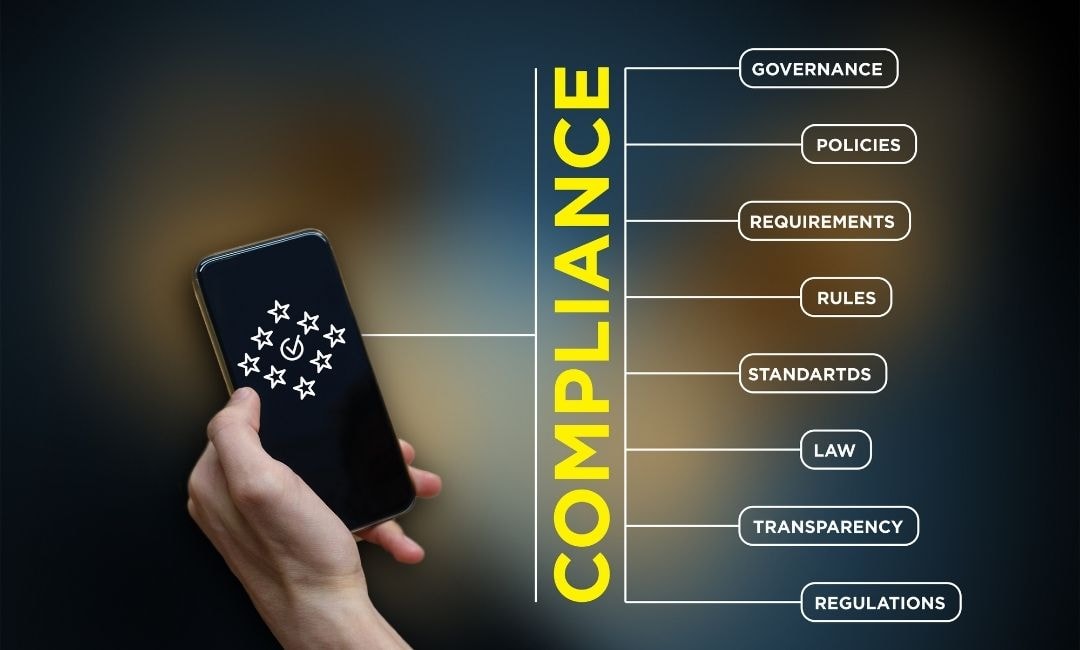
Staying compliant means tracking multiple deadlines throughout the year. This table consolidates every critical timeline mentioned above for easy reference.
Master Compliance Calendar for NYC Landlords
Keep this timeline handy — missing any deadline can trigger immediate HPD violations and fines.
| Violation Type | Inspection/Maintenance Schedule | HPD Correction Window | Key Compliance Dates |
| Pest Infestations | • Monthly professional inspections• Quarterly entry point sealing• Weekly garbage area checks | 21 days for Class B90 days for Class C | Year-round requirement |
| Mold Growth | • Quarterly plumbing inspections• 24-hour response to water complaints• Annual ventilation checks | 21 days for Class B90 days for Class C | Year-round requirement |
| Heat & Hot Water | • September: Pre-season boiler service• October & March: Temperature testing• December: Mid-season check | 24 hours for heat/hot water emergencies | Heat Season: Oct 1 – May 31Temps: 68°F day / 62°F nightHot water: 120°F year-round |
| Lead Paint | • Annual unit inspections• Annual tenant notices• 10-year record retention | 21 days for most violationsVaries for abatement orders | Annual Notice: By January 15Inspections: Where children under 6 reside |
| Window Guards | • Annual tenant surveys• March inspection of existing guards• 14-day replacement for defective guards | 21 days for installation | Survey Period: Jan 1-15Installation: By Feb 1Applies to: Children 10 & under |
| Smoke/CO Detectors | • Annual testing (all units)• Monthly 10% spot checks• 10-year device replacement | 30 days for Class B violations | Testing: Same week annuallyBattery replacement: Annual or 10-year lithium |
| Self-Closing Doors | • Quarterly testing & adjustment• Annual mechanism inspection (Year 4+)• Replacement at Year 6-7 | 30 days for Class B violations | Closing speed: 5-10 secondsGap tolerance: ¾ inch maximum |
Steer clear of common mistakes by following these timelines. Some violations are immediately hazardous, while others are non-hazardous but still require prompt attention.
Critical Compliance Reminders
Immediate action triggers that override standard timelines:
- Tenant complaints about heat/hot water — respond within hours
- Water leaks creating mold risk — fix within 24 hours
- Child moves into the unit — install window guards immediately
- Fire department inspection notices — correct before FDNY returns
Documentation requirements across all violations:
- Keep all records for a minimum of 3 years (10 years for lead paint)
- Photograph before/after conditions
- Get tenant signatures on completed work
- File all contractor certificates and licenses
Seasonal peaks when violations spike:
- October-November: Heat complaints surge
- January: Window guard surveys due
- Summer: Pest infestations increase
- September: Pre-heat season prep critical
Use this timeline to build your annual maintenance calendar. Set reminders 30 days before each deadline — giving yourself buffer time prevents last-minute scrambles when HPD shows up.
How ViolationWatch Helps You Avoid All 7 HPD Violation Triggers
Managing HPD compliance across multiple properties feels like juggling flaming torches — drop one, and you’re dealing with fines, tenant complaints, and emergency repairs. ViolationWatch transforms this chaos into a streamlined system that catches problems before HPD inspectors do.
Smart Technology That Keeps You Ahead of Violations
ViolationWatch uses an AI-powered monitoring engine that continuously scans for new violations across all NYC agencies. This means you get alerts about pest complaints, mold reports, heat issues, lead paint notices, and safety device violations the moment they hit the system — not weeks later when the fine arrives.
The platform addresses each of our 7 violation triggers directly:
Environmental Hazards:
- Pest violations — Track complaints and inspection deadlines automatically
- Mold issues — Monitor water-related complaints that signal mold risks
- Heat/hot water — Get temperature violation alerts during the critical heat season
- Lead paint — Manage annual inspection requirements and documentation
Safety Violations:
- Window guards — Track which units need guards based on tenant surveys
- Detectors — Schedule and document annual testing for all units
- Self-closing doors — Monitor maintenance schedules and compliance status
Real-Time Alerts Change Everything
The difference between a $250 fine and a $10,000 problem often comes down to response time. ViolationWatch sends instant notifications through multiple channels:
| Alert Type | Delivery Method | Response Advantage |
| New violations | WhatsApp & Email | Address issues within 24 hours |
| Upcoming deadlines | SMS & Dashboard | Never miss correction windows |
| Inspector activity | Push notifications | Prepare before inspections |
| Compliance updates | Email summaries | Track resolution progress |
You can add multiple team members to receive alerts — ensuring someone always catches critical violations even during vacations or emergencies.
Pricing That Scales With Your Portfolio
ViolationWatch offers two straightforward pricing options:
- Free Trial — $0/month
- Full platform access
- Monitor only one property
- No credit card required
- Per Address Plan — $9.99/address/month
- Everything in the free trial
- Dedicated compliance support
- Priority violation alerts
- Advanced analytics and reporting
Whether you manage one brownstone or 50 buildings, the platform scales to match your needs without breaking your budget.
How ViolationWatch Works in 4 Simple Steps
Getting started takes less than 10 minutes, and the platform immediately begins protecting your properties.
- Quick Property Setup: Add your properties using just the address — the system automatically pulls violation history and starts monitoring. No manual data entry or complex configuration needed.
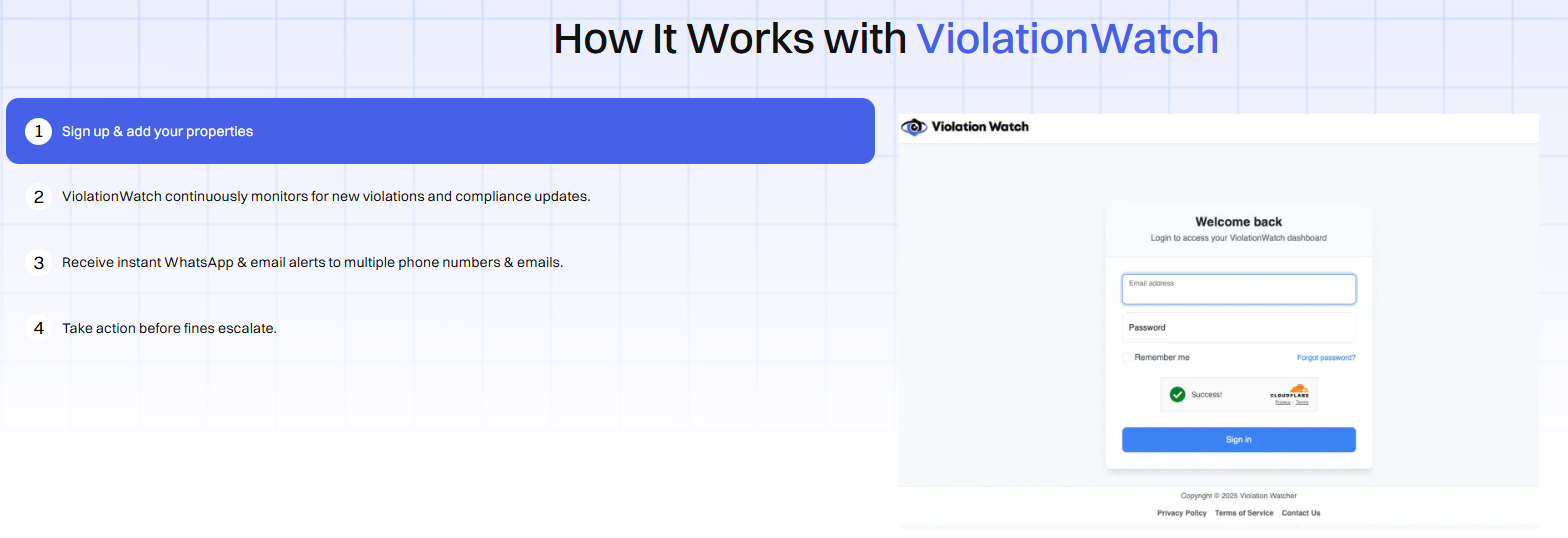
- Automatic Violation Monitoring: The AI engine continuously checks for new violations across DOB, HPD, ECB, FDNY, and other agencies. You’ll see everything in one unified dashboard with color-coded urgency levels.
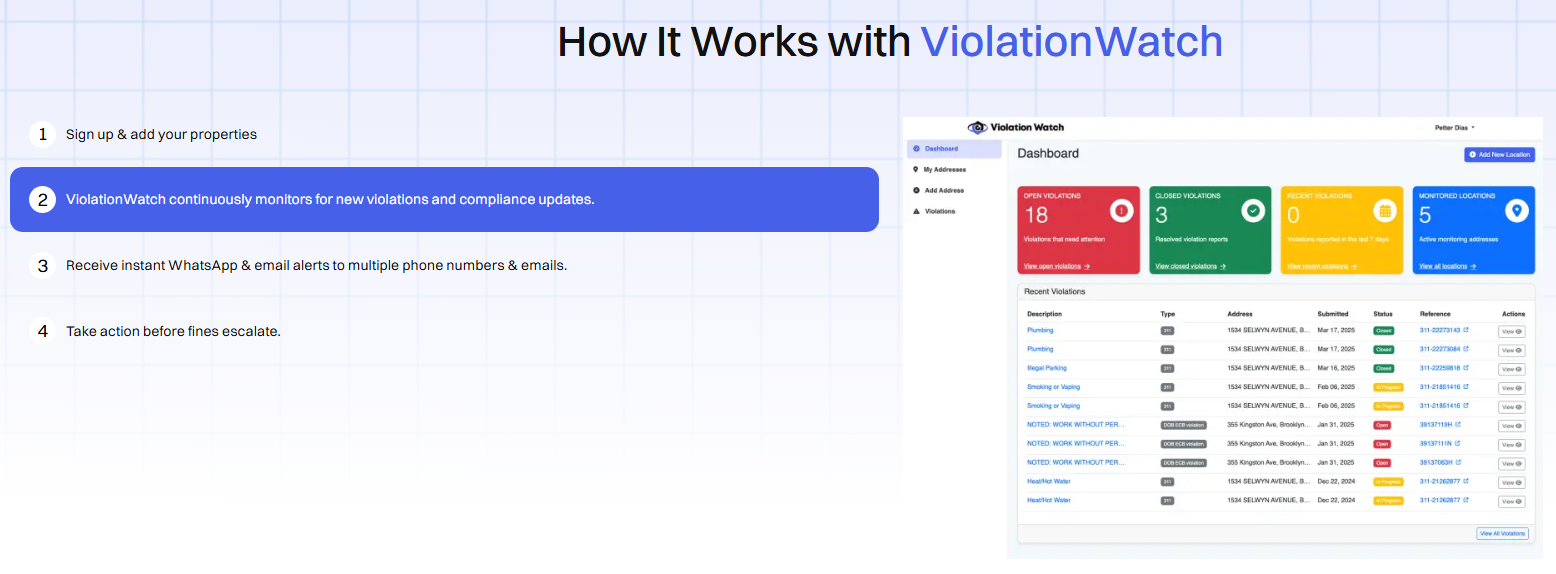
- Multi-Channel Alert Delivery: Choose how you want to receive notifications — WhatsApp for urgent issues, email for daily summaries, or SMS for deadline reminders. Add your whole team to ensure coverage.
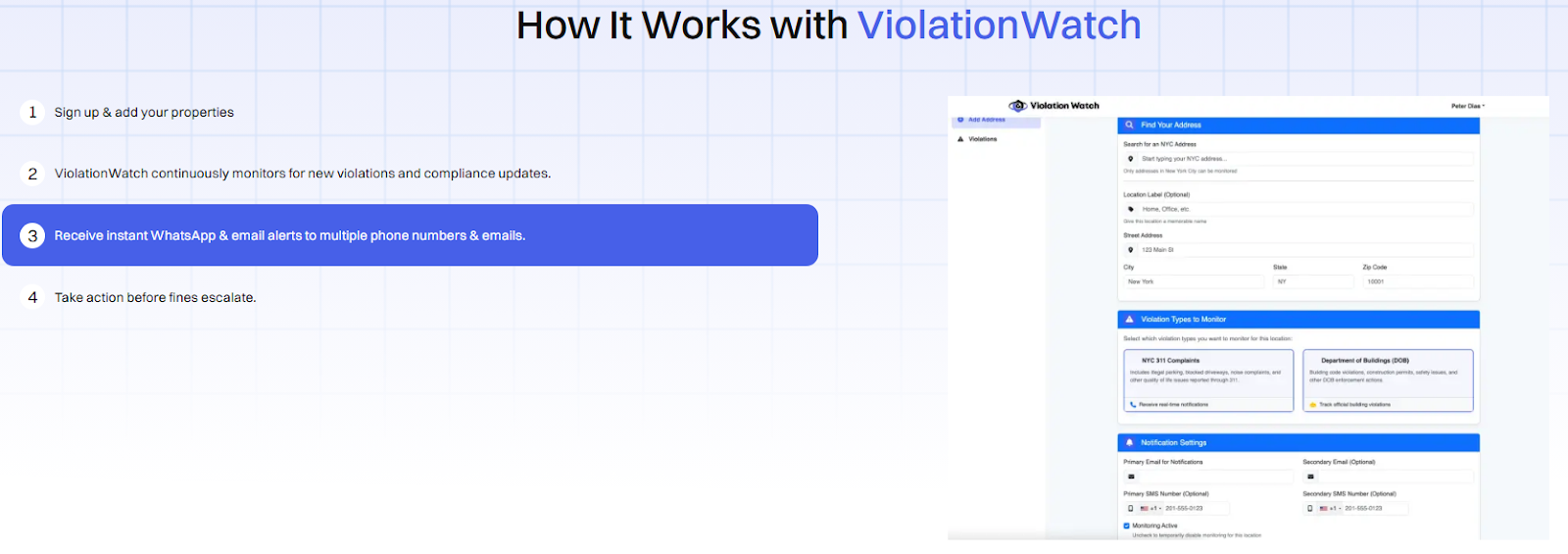
- Guided Resolution Process: Each violation comes with specific resolution steps, required documents, and compliance deadlines. The platform tracks your progress and reminds you of upcoming milestones.
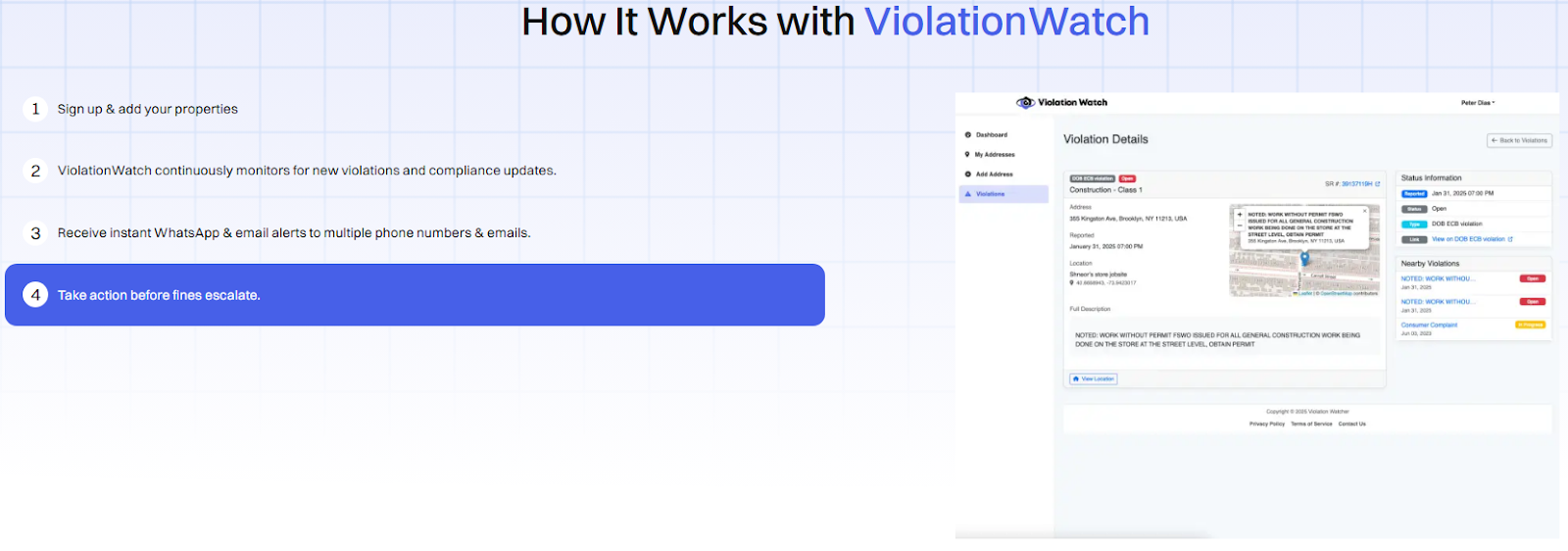
Dashboard Features That Save Time
The platform’s dashboard transforms overwhelming violation data into actionable insights:
Violation Overview Cards:
- Open violations requiring immediate attention
- Closed violations for compliance records
- Monitored locations at a glance
- Recent activity and trending issues
Smart Filtering Options:
- Sort by violation type (pest, mold, heat, etc.)
- Filter by urgency level
- View by property or portfolio-wide
- Track specific date ranges
Document Management:
- Upload correction documentation
- Store inspection reports
- Maintain compliance certificates
- Access everything from one location
Beyond Basic Monitoring
The platform helps you avoid inspection fees and ensures your properties meet all building codes. Rather than force compliance through fines, we help you stay ahead proactively.
ViolationWatch goes beyond simple alerts by providing strategic insights that help you prevent future violations:
- Violation patterns across your portfolio
- Seasonal trends to anticipate problems
- Cost analysis of violations by property
- Compliance scoring to identify problem buildings
The platform essentially acts as your 24/7 compliance department — catching issues early, organizing your response, and ensuring nothing falls through the cracks. For less than the cost of a single HPD fine, you get comprehensive protection across your entire portfolio.
Stop Playing Violation Whack-a-Mole — Use ViolationWatch
HPD violations don’t have to drain your time and profits. You’ve got the knowledge to prevent:
- Pest infestations
- Mold growth
- Heat failures
- Lead paint issues
- Safety violations
Now you need a system that puts this knowledge into action automatically.
Key takeaways to protect your properties:
- Environmental hazards cause 60% of violations — monthly pest control and quarterly plumbing checks prevent most issues
- Safety devices get inspected first — keep window guards, detectors, and self-closing doors compliant year-round
- Timing beats everything — respond to water leaks in 24 hours, heat complaints immediately
- Documentation saves you — photograph everything, maintain inspection logs, and keep records organized
Managing all these moving parts across multiple properties gets overwhelming fast. That’s exactly why we built ViolationWatch — to handle the tracking, alerts, and deadlines while you focus on running your business. Start your free trial today and see how much easier compliance becomes.

